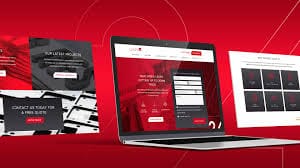Bounce rates can make or break a website’s performance. If visitors land on your site and quickly leave, it signals a problem—either with your content, design, or user experience. High bounce rates not only hurt conversions but also negatively impact SEO, making it harder for your website to rank on search engines. The solution? Thoughtful design paired with strategic content placement to engage visitors and guide them toward meaningful actions. In this blog, we’ll explore actionable strategies to reduce bounce rates and how DMN8 Partners can help you design a website that keeps users hooked.
1. Improve Page Load Speed for Immediate Engagement
The faster your website loads, the better. Studies show that 53% of users abandon a website if it takes longer than 3 seconds to load. Slow sites frustrate visitors and drive up bounce rates. How to Improve Page Speed:- Compress large images and files without sacrificing quality.
- Minimize the use of heavy animations or scripts.
- Use caching tools to load pages faster for returning visitors.
- Optimize your website for mobile devices, where load times are often slower.
2. Use Strategic Content Placement to Guide Users
Thoughtful content placement is key to keeping visitors engaged and helping them find what they need quickly. When users land on your site, their eyes naturally scan from top to bottom and left to right. Best Practices for Content Placement:- Above the Fold: Place critical information—like headlines, calls-to-action (CTAs), and benefits—at the top of the page.
- Use Visual Hierarchy: Make headings larger and bolder to guide attention. Break content into bite-sized sections with clear subheadings.
- Feature Engaging CTAs: Add CTAs like “Get a Free Quote” or “Shop Now” near key information to encourage action.
- Leverage White Space: Use spacing strategically to create balance and reduce clutter.
- A bold headline: “Protect Your Home with Expert Roof Repair Services.”
- A prominent CTA button: “Schedule a Free Inspection.”
- Client testimonials or service benefits below to build trust.
3. Design for Easy Navigation and User Experience (UX)
Your website’s navigation should be intuitive and seamless. If users can’t find what they’re looking for, they’ll leave—and fast. A well-organized site structure encourages visitors to stay longer and explore more pages. Key Navigation Strategies:- Use a clear menu at the top of your page with concise labels (e.g., “Services,” “About,” “Contact”).
- Add a search bar so users can quickly find specific content.
- Include breadcrumbs to show users where they are on the site.
- Use internal links to guide users to relevant pages or blog posts.
4. Add Engaging Visuals to Break Up Text
Walls of text are a major turn-off for website visitors. Adding high-quality visuals—like images, videos, and infographics—helps break up text, keep users engaged, and communicate information more effectively. Visual Content That Works:- Relevant Images: Showcase your team, services, or happy customers.
- Videos: Add short explainer videos or customer testimonials to keep users on the page longer.
- Infographics: Use graphics to simplify complex information or stats.
- Interactive Elements: Add sliders, animations, or hover effects to make content dynamic.
5. Optimize Your Content for User Intent
Content that aligns with user intent reduces bounce rates by delivering exactly what visitors expect. This means understanding what users are searching for and crafting content that answers their questions. Tips to Optimize Content:- Write Clear, Benefit-Focused Headlines: Communicate value upfront, like “Get Affordable Plumbing Repairs in Cincinnati Today!”
- Address Pain Points: Use blog posts, FAQs, and service pages to answer common customer concerns.
- Add Internal Links: Direct users to related content to keep them engaged (e.g., “Read More About Our Roofing Services”).
- Make Content Scannable: Use bullet points, bold headings, and short paragraphs to improve readability.
6. Include Trust-Building Elements
Visitors are more likely to stay on your site and engage with your content when they trust your business. Add trust signals that reassure users they’re in the right place. Trust-Building Strategies:- Customer Reviews and Testimonials: Showcase 5-star reviews and success stories.
- Certifications and Badges: Display awards, certifications, and security badges to establish credibility.
- Real-Time Chat Support: Offer live chat to address visitor questions instantly.
- Clear Contact Information: Add a visible phone number, email, and location details to make it easy to reach you.
FAQs About Reducing Bounce Rates
Q: What is a bounce rate? A: Bounce rate refers to the percentage of visitors who leave your site after viewing only one page.Q: What is an ideal bounce rate? A: Bounce rates vary by industry, but anything below 50% is generally considered good.
Q: How does design impact bounce rate? A: A clean, user-friendly design improves navigation, readability, and trust—keeping users on your site longer.
Q: Can mobile optimization help reduce bounce rates? A: Absolutely. Mobile-friendly websites are essential as over 60% of traffic comes from mobile devices.

